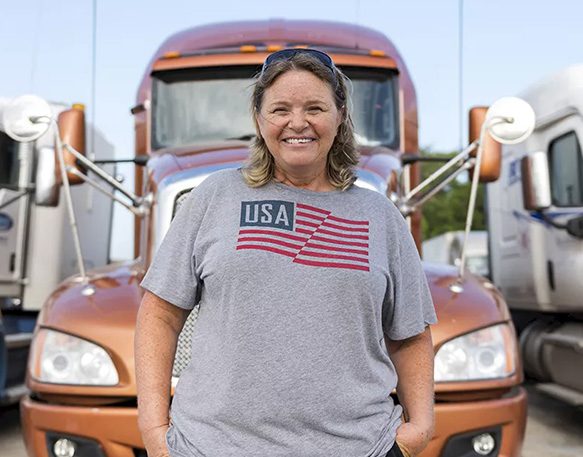How to thrive when the market is up and survive when it’s down
Like a lot of industries, trucking goes through up and down business cycles. These freight cycles define the market, and your job is to build a business that can thrive when the market is up and survive when it’s down.
Rising fuel prices, fluctuating market conditions, regulatory compliance, maintenance costs, and the general challenge of running a business are just a few of the hurdles you’ll encounter.
Driving a truck may be your expertise, but it takes more to run a successful business.
But don’t fret – each challenge is an opportunity in disguise, a chance to optimize, innovate, and grow. That’s where this guide comes in.
In Section 1, we’ll tackle business expenses, from insurance costs to fuel efficiency and cash flow management. We’ll provide you with tools to manage these costs and turn them into advantages.
Section 2 delves into operational excellence. Here, we’ll share proven practices for efficient truck routing, effective maintenance strategies, and tips to streamline your back-office tasks for enhanced productivity.
In Section 3, we shift gears and focus on maximizing your revenue in changing market conditions. Whether the market is booming or facing a downturn, we’ll equip you with strategies to keep your business profitable and thriving.
Section 4 is all about practicality. Here, you get tips and tricks that you can use immediately, from hiring the best talent to building strong customer relationships and staying ahead of industry regulations.
Section 1: Tackling Business Expenses
Expenses are a part of running any business, but if you’re creative and willing to use all the available tools to your advantage, you can certainly optimize your spending.
Strategies to optimize insurance costs
Many business owners waste time and money by overpaying for insurance coverage they don’t need. To avoid this, shop around for the best rates and compare different coverage plans to ensure you are only paying for the insurance you use.
It’s also essential to look for an insurance provider who understands the unique needs of trucking businesses like yours. Find one with experience and familiarity with the relevant regulations and requirements. A provider that knows how to assess risk and offers competitive rates can help you get the coverage you need at a price that fits your budget.
Reducing fuel costs
As you surely know, diesel is the biggest expense for most trucking businesses. But there are several ways that businesses like yours can add extra control over fuel costs.
Using a dedicated fuel card for diesel purchases is another way carriers can mitigate expenses. A fuel card can be one of the fastest ways to drive real savings. The right fuel card can be accepted at thousands of locations and help optimize discounts on every route. A good fuel card can offer significant savings off the posted per-gallon cash price, along with additional discounts on tires, alignment, and preventative maintenance.
These are just a few steps you can take to cut fuel costs, but you can also make the dollars you spend go further by simply driving slower and idling less. The rule of thumb is every 1 MPH increase in speed results in a .14 MPG decrease in fuel economy, or a saving of around $5,000 per year by driving at 65 MPH instead of 75 MPH. Other fuel-saving techniques include idling less, investing in drag-reduction kits, and reducing deadhead miles by using a load board like the one on DAT One.
Finally, DAT’s unique TriHaul™ tool can help reduce fuel costs by providing suggestions for triangular routes that help carriers circumvent low-paying lanes and backhaul rates. TriHaul offers five route suggestions, which carriers can compare and contrast based on average rate per loaded mile.
Use factoring to your advantage
Carriers need capital to keep the wheels turning, literally and figuratively, and one of the best ways to maintain cash flow is leveraging freight factoring, a simple method for having cash on hand without taking on any additional debt or interest payments.
If you’re new to running a carrier business, those first 30 days can be absolutely brutal – you’ve fronted a lot of money to start working, and you’ve got a long way until you bring money in. Factoring is your friend here.
For those new to this concept, freight factoring uses a third-party provider to purchase your unpaid invoices, providing you with quick money you’ve already earned carrying loads without the frustrating need to wait days or weeks for payment. The factoring company pays you what you’re owed while they wait for payment. It’s an ideal solution for trucking companies since it eliminates long wait times for payments from customers, not to mention the risk of not getting paid at all.
Freight factoring is fast and easy to set up. All you need to do is supply the relevant invoices and the factoring company takes care of the rest. This eliminates any extra paperwork or delays in getting paid, allowing you to focus on what matters most – growing your business.
Section 2: Operational Excellence
Running your trucking business on a daily basis can become an exercise in efficiency if you know certain tips and strategies. Here are some ways you can cut costs by operating with maximum awareness.
Efficient routing
Efficient truck routing is a crucial aspect of operational excellence. It not only ensures timely deliveries but also contributes to fuel efficiency and driver satisfaction. But how do we achieve this?
Leverage technology. Tools like DAT One help you and your team plan the most efficient routes, taking into account factors like traffic, distance, and delivery windows. This allows them to navigate around unexpected roadblocks or traffic jams, ensuring on-time deliveries. Beyond this, optimizing routes is an excellent way to eliminate deadhead mileage. DAT One delivers information you can use to choose routes that will enable you to secure a load for your return trip, helping you maximize profitability.
Second, invest in training your dispatchers and drivers. Ensure they understand the importance of efficient routing and can use the tools and technologies effectively. And here again, TriHaul can be an extraordinarily valuable tool.
Maintenance strategies
A well-maintained fleet is the backbone of your motor carrier business. Regular preventive maintenance (PM) can help avoid costly breakdowns, ensure safety, and maximize the lifespan of your vehicles. Most importantly, it puts you in charge.
Here’s where a proactive approach comes in handy. Implement a regular maintenance schedule based on manufacturer recommendations and stick to it. Train your drivers to identify early signs of potential issues. Remember, an ounce of prevention is worth a pound of cure.
It’s likely that any preventative maintenance will result in some repairs because, with trucks, there’s always something that needs fixing. But a good preventative maintenance program aims to control your repairs and schedule rather than incur uncontrolled repairs that usually happen at the worst possible time. Successful owner-operators often wash their truck by hand or, in the case of a small fleet, pay their drivers to take a closer look at their truck and trailer. It’s during the washing process most minor repairs are noticed.
“It’s important to set aside a maintenance reserve for repairs, especially major ones,” Croke says. “Depending on the truck’s age, set aside around ten cents per mile for a three-year-old truck and as much as 12 cents per mile for anything five years or older. Then add another two cents per mile for every 100,000 miles over 500,000 miles”.
Streamlining tasks for productivity
Last but not least, let’s talk about back-office support. While it might not be front and center, efficient administrative operations are critical for smooth business functioning.
To streamline these tasks, consider automation. Tools like automated invoicing, payroll processing, and inventory management can save time, reduce errors, and increase productivity. DAT’s carrier TMS partner, LoadOps, delivers just this level of automation. It streamlines your day-to-day operations by seamlessly integrating with your preferred systems and keeping you connected with both your fleet and your customers.
As with any segment of your operation, regularly evaluate and update your processes to ensure they continue to serve your business effectively.
In conclusion, operational excellence isn’t about being perfect. It’s about continuously improving, learning from mistakes, and striving to improve. As we move forward on our journey, remember that every step toward operational excellence is a step toward success.
Section 3: Revenue Maximization in Changing Markets
It’s obviously easier to make money when the market is thriving, but the trucking businesses who remain in the game for the long haul know how to adjust when the market shifts. Here are some strategies to help you achieve just that.
Strategies to maximize revenue in a booming market
When the market is booming, it’s time to seize the day and maximize your revenue. But before we explore the available strategies to do that, a word about savings is necessary.
The trucking industry ebbs and flows, and each year we encounter periods of both boom and bust. It is imperative that any plan to grow or expand your business also includes a strategy for saving money and providing yourself a safety net to sustain you through the low times.
It can be tempting in times of profitability to spend some of the resulting windfall on goods and services we’d deem “want to haves” rather than “need to haves.” Resist that temptation. You’ll be proud and grateful in the long run if you instead resolve to put a certain percentage of your profit into a low-risk savings option (e.g., a high-yield savings account). The safety net that evolves from that decision will support you during slow markets, enabling you to operate with confidence when others may be forced to exit the industry due to a lack of savings.
Now, back to making that money. The easiest and most convenient way to find paying loads in a booming market is with a load board like the one included in DAT One. Such boards enable the filtering of data (e.g., available loads, rates, etc.) in a way that delivers information about actionable loads that suit your trailer type, location, and other criteria. Rate data in a load board is especially revealing. In big markets, you’ll identify where there’s more money to be made. In poor markets, you’ll know if you’re paying a fair price to move goods, because especially then, every penny counts.
Another effective strategy in a booming market is to expand your customer base. This could mean targeting new industries, expanding into new regions, or offering new services. This is another instance where load boards prove useful, allowing you to advertise your available trucks.
“Being able to post my truck’s availability, that essentially allows brokers to find me a lot faster and helps me to continue to grow my business,” explains Victor Newton of Newton Ventures
Also, consider investing in your business. Whether it’s upgrading your fleet, investing in new technology, or expanding your team, using your increased revenue to fuel growth can set you up for long-term success.
When operators look to invest in their business, they sometimes overlook the less tangible investments such as superior customer service and relationship building. The stronger your relationships are during the booming markets, the stronger they’ll be when the market is putting a squeeze on your business. And strong relationships will sustain you during tough times. Get proactive now and build strong relationships.
How to thrive in unfavorable market conditions
Unfavorable market conditions, such as economic recessions, are challenging. With the right approach, you can weather the storm and even find ways to thrive. We’ve already explored the importance of establishing a safety net of savings you can access during the inevitable periods of market slowdowns. Having the security of that safety net significantly changes the experience of working in this industry, particularly when those who fail to prepare for down markets are often forced to leave the industry.
As for the other factors that can help you in unfavorable market conditions, focus on maintaining strong relationships with your existing customers. They are your most reliable source of income during tough times. Ensure you’re providing exceptional service that keeps them coming back. Like any other business, customers are eager to work with people they like. Use this to your advantage and curry favor with your customers.
As outlined in the previous sections, it’s important to keep a close eye on costs. This is a time to tighten your belt and eliminate any unnecessary expenses—what that looks like will likely differ from trucker to trucker, depending on a variety of factors that are unique to your business. However, be careful not to compromise on the quality of your services or the morale of your team. Learn where the line is and take a hard look at what is a need for your business versus what’s nice to have.
Lastly, stay adaptable. Be ready to pivot your strategies based on changes in the market. It’s all about staying nimble and being able to quickly respond to new challenges and opportunities. You may have to adapt your salary payouts, either for yourself or for your team.
DAT One also includes essential tools like the Profit Estimator, which enables carriers to determine how much they’ll earn on a load (based on operating costs and goals) before they agree to haul it.
Tools like LaneMakers are handy here, too. You’ll get a look behind the curtain and see the lanes brokers are most active on. With that insight, you’ll be able to cast a wide net, and build a large network that can weather the storm of poor markets.
Exploring new revenue streams
Lastly, let’s talk about diversifying your revenue streams. This is a powerful strategy for enhancing your business’s stability and opening up new avenues for growth. Wide roots make for strong trees.
Consider offering ancillary services such as warehousing, logistics consulting, or last-mile delivery. You could also explore partnerships with other businesses, where you can offer complementary services and share revenue.
Another option is to add a freight brokerage to your operations. Some carriers find that, as they grow their business and foster relationships with their shipper customers, those customers have more freight needs than their own fleets can service. One option is to expand your fleet, but another is to diversify your revenue streams by brokering that freight to other carriers.
While this saves you from having to invest in a new truck and/or trailer, there are still costs and legal considerations associated with adding a brokerage. For one, your freight broker operation has to be a separate business from your motor carrier business, and it requires its own operating authority from the FMCSA.
Maximizing revenue in changing markets is about being proactive, adaptable, and strategic. It’s about knowing when to tighten your belt, when to invest, and when to explore new opportunities. As we continue our journey on the highway of success, keep these strategies in mind. They’ll serve as valuable guideposts, helping you reach greater profitability and success.
Section 4: Immediate Implementation
The following is a short list of strategies you can implement right now to upgrade the talent, customer service, and legal compliance areas of your trucking business.
Strategies for attracting and retaining top talent
Having a team of dedicated, skilled professionals is invaluable. But attracting and retaining top talent can be a challenge. Here are a few tips to help.
- Offer competitive compensation: This doesn’t just mean a good salary, but also benefits like health insurance, paid time off, and retirement contributions. Don’t view employees as stopgap measures or temporary. Employees treated as temporary will behave as such, and that can be costly. Turnover costs a trucking company between $6,000 and 12,000 per driver.
- Provide growth opportunities: Show potential hires that they have room to grow within your company. This could be through professional development programs, mentorships, or clear pathways to advancement.
- Cultivate a positive work environment: People want to work where they feel valued and respected. Foster a culture that encourages collaboration, open communication, and mutual respect.
Building strong customer relationships
Your customers are the lifeblood of your business. Building strong relationships with them is key to ensuring repeat business. Here’s how:
- Deliver exceptional service: Always strive to exceed customer expectations. Be reliable, be responsive, and always deliver on your promises.
- Communicate regularly: Regular communication helps keep your business top of mind and shows customers that you value their business. This could be through newsletters, social media, or personalized emails, it doesn’t have to be fancy.
- Ask for feedback: Show your customers that you value their opinions. Ask for feedback and use it to improve your services.
Navigating compliance
Compliance with regulations is a must in the motor carrier industry. But it can be complex and overwhelming. Here’s how to stay ahead:
- Stay informed: Regulations change frequently. Make it a habit to regularly check regulatory websites such as Overdrive, subscribe to industry newsletters, and attend relevant webinars or training sessions. Consider hiring a dedicated employee to handle compliance.
- Implement compliance programs: Develop and implement compliance programs within your organization. This not only helps ensure adherence but also sends a message that you take compliance seriously.
- Seek expert advice: Don’t hesitate to seek advice from experts. This could be legal counsel, compliance consultants, or industry associations. One place to start might be ATBS for their expertise in bookkeeping and tax services.
Ready to build a resilient business ready for any market? Click here to start your journey.




